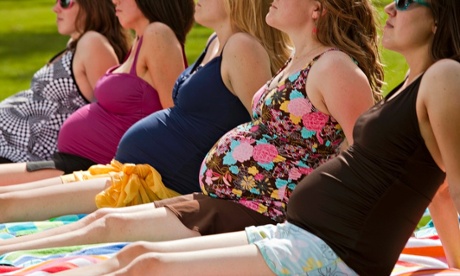
Doctors are urging pregnant Australian women to tell them about their use of complementary and alternative therapies after a new study found 90% are using such treatments, often on the advice of their friends and families.
Using data from the Australian Longitudinal Study on Women’s Health pregnancy sub-survey of more than 1,800 women, researchers found almost half consulted a complementary and alternative medicine (CAM) practitioner and almost 90% used a CAM product during pregnancy. More than 40% were influenced to do so by family and friends, while about half were influenced by their own use of CAM in the past.
“It is noteworthy that women were not significantly influenced by professional maternity healthcare providers when deciding to consult a CAM practitioner,” the study said.
Pregnant women experiencing back pain, sciatica, nausea or who were preparing for labour were most likely to take the advice of friends and family to see CAM practitioners, the researchers from Sydney and Queensland found. The findings were published in the Journal of Alternative and Complementary Medicine.
Study lead author and research scholar from the University of Technology’s Australian Research Centre in Complementary and Integrative Medicine, Jane Frawley, said women were also using the internet for advice on complementary medicine, but not as much as she anticipated.
“This may be due to issues around trust,” she said.
“Women may not always trust the internet, but a friend or family member saying that they found a particular remedy helpful for a particular pregnancy symptom is a powerful endorsement.”
Many of the therapies women use are safe or have no effect. But Frawley said women should be aware that natural did not always mean safe, and some were potentially harmful, especially during pregnancy.
She was concerned women may be delaying or avoiding conventional treatment for a potentially dangerous condition, such as a urinary tract infection. Women may be worried about being judged for their CAM use by their GPs, she said, despite many obstetricians and midwives being open-minded towards some complementary treatments.
“Women should always discuss their use of CAM with their maternity healthcare provider,” she said.
President of the Royal Australian College of General Practitioners, Dr Liz Marles, said it was important for doctors to be non-judgmental about use of unconventional treatments.
“Most women are really trying to do the right thing for their baby and doctors need to understand that,” she said. But doctors also needed to be honest if a patient’s CAM use could be harmful, she said.
“I would definitely like to know if my pregnant patients were receiving any form of spinal manipulation, or if they were taking any herbal remedies, because they often contain some quite potent substances.”
The Australian Natural Therapies Association, whose members include homeopaths, naturopaths and aromatherapists, state on their website that their members have full access to an interactions database covering more than 700 herb-drug, supplement-drug, and food-drug interactions. They say the website is updated weekly.
Royal Australian and New Zealand College of Obstetricians and Gynaecologists vice-president, associate professor Steve Robson, said he saw CAM use among his patients “all the time”. Patients often had no idea what they were taking, he said.
“Very recently I had a patient come in with a bottle of something given to her by a CAM practitioner and asked if it was safe to take it, but I had no idea what was in it – it was impossible to tell what was in it,” he said. Another pregnant patient told him she was taking a herbal remedy for a bowel problem, despite much more effective conventional treatments being available.
But many others patients did not disclose their use of alternative therapies at all, he said.
“Doctors prescribe treatments within a strong regulatory framework, where drugs are rated for safety and we know how to use them and of any potential side-effects,” Robson said.
“Women will check with me if it’s safe to take a panadol, but won’t disclose less evidence-based treatments.”
Some CAM substances, including herbal remedies, could affect the hormones or electrolyte balance of pregnant women, he said. He was particularly concerned about non-health professionals attempting to turn babies from the breech position, rather than performing the potentially fraught procedure in a hospital with doctors and midwives present.
Robson believes women may be influenced by CAM practitioners because they have more time than doctors to sit down and talk to them.
“Doctors and midwives are often rushed, but CAM practitioners will make a big fuss over someone and spend up to an hour with them,” he said.
“That must be very appealing. But pregnancy can be such a time of vulnerability, and some of these alternative treatments have no evidence base whatsoever and have the potential for downsides.”

